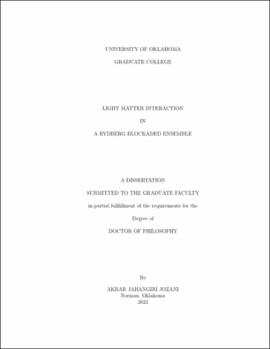| dc.description.abstract | This thesis presents a study of the interactions between two Rydberg atoms and Rydberg atomic ensemble with a monochromatic light field. The first part of the thesis covers the interaction between two Rydberg atoms. The result of this calculation for two Rydberg atoms is compared to an experiment and single atom Stark shift calculations. The pair-potential curves for interacting Rydberg atoms in a constant electric field are calculated. We use the pair-potentials to determine the effective dipole-dipole coefficient $C_3$, and van der Waals coefficients $C_6$. We compared the $C_3$ and $C_6$ coefficients to the experimental results. The experiment is performed for a quasi one dimensional trap at ultracold temperatures. In the experiment the angle of a polarizing electric field is varied with respect to the trap axis. The dipoles produced via polarization of the atoms have an angular dependent dipole-dipole interaction. We focused on two Rubidium Rydberg atoms in $50S_{1/2}$ states interacting in the blockade regime. For internuclear distances close to the blockade radius $R_{bl}\approx4–6$ $\mu$m, molecular calculations are in much better agreement with experimental results compared to those based on the properties of single atoms. The calculation based on single and independent atoms for $C_3$ and $C_6$ was used to analyze the original experiment. Our result shows that the calculated $C_6$ coefficient is within $8\%$ of the experimental value while the $C_3$ coefficient is within $20\%$ of the experimental value.
The second part of the thesis is a theoretical study of the interaction between a few atoms in a Rydberg ensemble in a monochromatic light field. We presented the solution of the full many-body master equation for an ensemble of two-level atoms. For a few atoms, through a full many-body master equation, it is possible to capture the main features of the physics of the problem. Our results demonstrate the capability of a full many-body master equation with a few atoms to investigate the novel quantum phases in long-range interacting quantum systems. The system's response to the driving laser field was studied by calculating the susceptibility, the correlation between Rydberg excitations, and excitation statistics. We studied the time evolution and the medium's response to the applied optical field. We calculated the linear dispersive and absorptive parts ($\chi_R$ and $\chi_I$) of the susceptibility of the medium for various densities of the atomic ensemble. The nature of interactions between the atoms follows the van der Waals behavior and is inversely proportional to the sixth power of the internuclear distance, $R$, between two atoms $ \propto \, 1/R^6$. In our calculations, we randomly generate the atoms' positions in a three-dimensional experimental box. This results in shot-to-shot fluctuations of the observables, such as susceptibility, which depends on atoms' positions relative to each other. The fluctuation of the observables (susceptibility and Rydberg excitations) happens around the transition boundary between two phases of the system. These fluctuations are quantum fluctuations since the temperature is set to be zero in the calculations. The critical parameters at which the transition of the system happens, such as critical density $n_{crit}$, are presented. We found that the system of interacting Rydberg atoms experiences a phase transition (at resonance, $\Delta=0$) from a classical individual interacting atoms in the weakly interacting regime into a many-body quantum interacting regime in the strongly interacting regime at critical density $1.6\times 10^{10}\lesssim n_{crit}\lesssim 6.25\times 10^{10}$ cm$^{-3}$. We found the Rydberg blockade radius $R_{bl}$, through the pair correlation function by sweeping the parameter space ($\Omega$ and $\Delta$). Defining the reduced control parameter $\alpha$ and $\delta$, we investigated the features of the second-order phase transition close to the transition critical point ($\alpha\rightarrow 0$ and $\delta=0$). We define the order parameter to be the Rydberg excitation fraction $f_R$. The phases are separated by analyzing the behavior of this order parameter. $f_R$ shows a power-law behavior close to the critical point with critical exponent $\mathcal{V}\sim0.446$.
In the last part, the full many-body master equation for an ensemble of three-level atoms inside a cavity is presented. We investigated the result of the cavity quantum electrodynamics (CQED) experiment in our group. We calculated the susceptibility through a full many-body density matrix calculations and used its result to study the transmitted light from the cavity. In the experimental analysis, the effect of the interaction between atoms is not considered. However, this can affect the result obtained through the many-body master equation calculations where these effects are considered. The future goal for the CQED experiment is to observe single-photon source by means of Rydberg blockade in the cavity. For this reason, the interactions between atoms need to be considered in the calculation and experimental analysis. To examine the effect of adsorbates on the surfaces of the mirrors of the cavity, we performed a pair-potential calculation in the background electric field of 1.6 V/cm created by the absorbates. | en_US |

